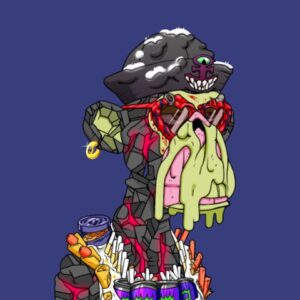Bitcoin is arguably the very first modern cryptocurrency. But what was the first NFT? Who created it and why? Artist Kevin McCoy is thought to be the first person to create an NFT in a collaborative project with Anil Dash. The result was a piece of art called Quantum, minted on the Namecoin blockchain in 2014.
The First NFT?
Kevin McCoy teaches art at New York University, lured into the arts by experimental filmmakers while working in Paris in the 1990s. When he decided to try his own experimental art with blockchain technology, his motivation was partly fueled by the enigma of Satoshi Nakamoto’s Bitcoin project.

McCoy was interviewed in an ARTNews article in February 2022 and said then that the public/private nature of the Bitcoin project caught his attention and he started thinking of ways that digital artists could utilize the blockchain for artistic projects.
McCoy spent a good portion of 2013 developing ideas, trying to use blockchain tech in a different way rather than creating a new platform or software. He worked on early versions of an artwork known as Quantum, which he later got help refining. The art itself was sourced from McCoy’s digital sketches and animations.
The artist notes that if the first NFT had been minted by someone other than an artist, the image might have been a bit more “on the nose” in the form of a visual representation of a Bitcoin or (worse yet) a random image chosen without much forethought. Quantum, on the other hand, was an artwork in progress when it was selected.
Kevin McCoy And Anil Dash
Quantum, the artwork that would ultimately become the first NFT, began as McCoy’s work but it evolved into a more collaborative effort in terms of getting the work minted.
What was needed? One important issue involved something we take for granted today on the blockchain; the necessity for metadata that proves ownership and identifies the artwork’s creator. At the time, Dash and McCoy felt the Namecoin blockchain supported such features best; Namecoin was the blockchain the art would ultimately be minted on.
The Debut Of The First NFT
If it’s true that Quantum was the first NFT, that means that the very first exhibit of this new art form experienced a most high-visibility debuts ever. Dash and McCoy did the very first live presentation of an NFT artwork at the New Museum Of Contemporary Art in New York City.
Quantum was auctioned for over a million US dollars in a Sotheby’s auction in 2021.
Aftermath Of The First NFT
Anil Dash and Kevin McCoy changed art history when they created the first NFT, but how do they feel about what’s happened since then? McCoy has been quoted in the press saying after trying in vain to promote what some have called tokenized art, he decided to step back from the project.
There was no indicator that Ethereum would come along to change the NFT landscape for good. Once Ethereum became known as a place to buy and sell NFTs, the rest would be downhill but at the time there was no indication that NFT art would ever catch on.
McCoy is quoted saying he felt NFT art was a very big art idea but there was no way to predict what would happen.
Anil Dash wrote for The Atlantic in spring of 2021 saying the “dream of empowering artists” using the blockchain has yet to come true but that NFTs did seem commercially viable. One thing Dash mentions is that in the days of Quantum it was hoped that one could eventually store an entire artwork on the blockchain and not just a shortcut to it.
Years later, that so-called shortcut is still the primary way many do business with NFTs. Artists must rely on third parties and trust that their artwork will not simply disappear.
NFT Controversy
When Quantum was sold in 2021 in that Sotheby’s auction, trouble was coming but nobody knew it. The sale for $1.47 million brought a lawsuit by a Canadian company called Free Holdings, which alleges it has the rights to the first NFT because the original creator failed to “renew ownership” of the NFT.
But McCoy asserts that rights and ownership of the original artwork in his sketchbook had been transferred to the NFT, while the suit’s plaintiff asserts this is either not true or is irrelevant.
Current interpretation of U.S. copyright law may not agree with that assertion but the lawsuit moved forward regardless. One reason? The terms of service on the blockchain Namecoin where Quantum was minted includes a requirement that the NFTs minted on that blockchain be reclaimed every 250 days. The lawsuit claims McCoy allowed the NFT renewal to expire.
U.S. copyright law doesn’t necessarily observe nuances in the delivery systems for copyrighted material so how such a suit might play out depends on how tech-savvy or tech-ignorant those presiding over the suit might be.
In the same way that the Digital Millennium Copyright Act or DCMA was technologically ill-informed, the same risks that allowed DCMA Section 21, the anti-circumvention rules in the act essentially made it a potential crime to tinker with one’s own devices or software. Will such badly-informed thinking find its way into a decision in such a lawsuit? Only time will tell.
Joe Wallace has covered real estate and financial topics, including crypto and NFTs since 1995. His work has appeared on Veteran.com, The Pentagon Channel, ABC and many print and online publications. Joe is a 13-year veteran of the United States Air Force and a former reporter for Air Force Television News.


